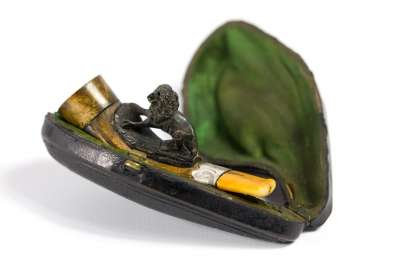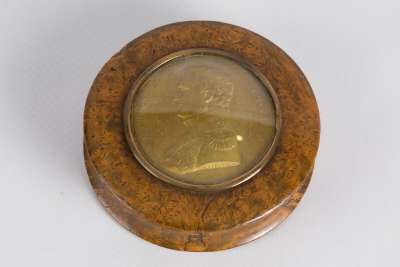This antique English brass pipe tamper, crafted in the late 19th century, is designed in the form of a sledgehammer. It dates back to circa 1880-1890 and reflects the craftsmanship of the era. The tamper's compact yet intricate design highlights the skill of its maker, showcasing an elegant balance between form and function. The brass material gives it a subtle sheen, while the sledgehammer form adds a unique touch to its appearance. This piece is emblematic of the period's attention to detail and functional artistry, making it a fascinating addition to any collection of smoking-related antiques.
Condition Report
The pipe tamper is in good condition, with wear consistent with its age and use. The brass surface displays a natural patina that has developed over time, enhancing its historical appeal. Minor scratches and marks are present, typical of a piece that has seen practical use. These do not detract from its structural integrity or overall visual appeal. There are no significant dents or damages that would compromise its functionality or decorative value. The tamper retains its original form with no repairs or alterations, preserving its authenticity as a 19th-century artefact.
Dimensions
Weight: 25gm, Length: 1.5cm, Width: 1.5cm, Height: 6cm.
A Companion for the Pipe Smoker
Originally intended as a tool for pipe smokers, this tamper served a specific function in the preparation of tobacco for smoking. The tamper's design allowed smokers to pack tobacco evenly into the pipe bowl, ensuring a consistent burn. Its sledgehammer shape not only provides an interesting visual motif but also offers a comfortable grip for the user. Such items were essential for those who valued a well-maintained pipe, highlighting the importance of proper smoking technique in the era.
Victorian Era Craftsmanship
This pipe tamper is a fine example of Victorian era craftsmanship, where even the most utilitarian objects were designed with a sense of style and attention to detail. The late 19th century was a period that saw a blend of industrial advances with traditional handcrafting skills. This piece reflects those values, combining the robust nature of brass with a form that is both practical and aesthetically pleasing. The choice of brass not only provided durability but also a touch of elegance, making the tamper a desirable accessory for the discerning smoker.
The Art of Metal Crafting
The creation of this brass pipe tamper involved several stages of metalworking, including casting and detailed finishing. Brass, an alloy of copper and zinc, was chosen for its durability and ability to develop a rich patina over time. The casting process would have required skilled artisans to create moulds that captured the intricate details of the sledgehammer design. Following casting, the piece would be cleaned and polished by hand, enhancing the intricate details and ensuring the tamper's functionality. The manual craftsmanship involved in its production is a testament to the skills of 19th-century metalworkers.
Unattributed English Craftsmanship
While the maker of this pipe tamper is not specifically identified, it is representative of the quality and style typical of English metalwork from the period. Many such items were produced by skilled artisans working in small workshops across England, often without leaving a maker's mark. These craftsmen were adept at creating a wide range of items for everyday use, combining functionality with artistic expression. This tamper stands as a tribute to their craftsmanship, showcasing the understated elegance and practicality that defined English metalwork of the late 19th century.
Collected by Enthusiasts of Smoking Antiques
Antique pipe tampers like this one are coveted by collectors who appreciate the history and artistry of smoking accessories. These items hold a particular fascination for those interested in the social and cultural history of smoking. Collectors value them for their historical significance and the insight they provide into past smoking habits and practices. The tamper's unique design and period-specific construction make it an appealing addition to any collection focused on tobacco-related paraphernalia. Its presence in a collection reflects a deep appreciation for the craftsmanship and cultural context of the Victorian era.













